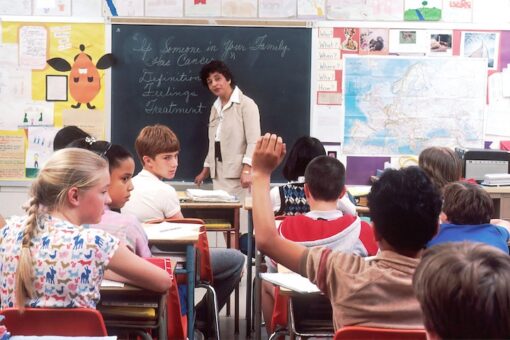What Research Tells Us about Classroom Decor
A MiddleWeb Blog
 I have two colleagues who couldn’t differ more in their approach to classroom decoration.
I have two colleagues who couldn’t differ more in their approach to classroom decoration.
The first teacher’s door, walls, and even ceiling are adorned with crafts, posters, mobiles, and brightly colored murals that correlate with various topics and themes studied throughout the school year.
The other teacher’s classroom is simple, spartan…even sterile. I’ve wondered on occasion which approach is best for students.
After all, it’s clear that the environment we work in impacts both our behavior and performance. Studies by environmental psychologists illustrate how color schemes, lighting, and even the appearance of the waitstaff in restaurants influence our dining habits.
Over the past decade, companies like Google, Facebook, and Pixar have pumped billions into designing workspaces for employees that foster collaboration, creativity, and productivity.
Now there is a growing body of research about how the visual environment of a class impacts – and if we’re not careful hinders – students’ attention and learning. If we’re not cautious, our well-intentioned efforts to spruce up the classroom can devolve into visual noise, color variability, and decorations that distract learners and distort their ability to focus on academics.
As a parent and teacher, I’m cognizant of the vast number of digital distractions competing for young people’s attention and do my best to mitigate them. The same practice holds true for educators decorating classrooms.
Visuals compete for our attention
When multiple objects are present in our surroundings, they end up competing for representation in the visual cortex of our brains. Think of a bunch of performers feverishly acting on a small stage for the attention of a theatergoer. From our audience perspective, fewer performers allows us to focus better and understand what’s going on.
If you’re a teacher seeking to establish a balance between academics and ambience, consider these suggestions.
Declutter
I remember one year our school library ordered several new books to replace a number of well-worn, banged-up ones that were falling apart. The older titles were put up for grabs as were the bright book covers that came with the new ones.
I snatched as many of each as I could and set forth to immerse my students in the joy of reading. My class walls were soon plastered with colorful book jackets. Piles of old novels were left everywhere for my students to grab.
A colleague entered my “newly” decorated classroom a couple days later and gasped, ”How do your students even focus with all of this!?!” The fire marshal added insult to injury when, at the end of the month, he submitted a report to the principal citing my classroom as a fire hazard due to “excessive coverage of the walls with flammable material.” The message was clear: declutter your classroom and reduce the visual noise (not to mention the combustibles).
Visual noise refers to both the quantity of displays/decorations and the general amount of physical clutter present in the learning space. To reduce our visual noise, we need to start by examining each item and decoration. Consider stowing away anything that doesn’t have a direct, daily impact on learning and teaching.
If you look at something and it’s not an immediate “yes – I need this,” put it in quarantine for a while. If it ends up not being used, toss it or find it another home. When making future classroom decoration decisions, follow the tried-and-true principle of moderation.
Choose Colors Carefully
We often have considerable control over our classroom color choices. That’s a good thing. Color is an essential part of our learning environment and can affect students’ emotions and their perception of our sense of community and educational purpose.
A multitude of opinions and loosely supported theories circulate among educators about which colors are the most inviting, calming, and conducive to learning. The reality, however, is that many people have a preference for certain colors due to their cultural background, geographical region, and past experiences.
Still, there is some education research that proves helpful about colors in the classroom. Studies in 2013, 2015, and 2022, all agree that moderate levels of color (and less visual stimulation in general) have a more positive impact on student attention and achievement.
It’s not that classrooms need to be sterile. Experiment with color palettes (see this post by a 5th grade teacher on switching from themes to schemes). It’s simply that we should exercise caution and moderation when decorating…even if the teacher next to us insists on transforming their entire classroom into a tropical rainforest.
References
Godwin, K. E., Leroux, A. J., Scupelli, P., & Fisher, A. V. (2022). Classroom Design and Children’s Attention Allocation: Beyond the Laboratory and into the Classroom. Mind, Brain, and Education. https://doi.org/10.1111/mbe.12319
Stroebele, N., & De Castro, J. M. (2004). Effect of ambience on food intake and food choice. Nutrition, 20(9), 821-838.
Feature photo: Unsplash




































I hope this article does not deter teachers from putting at least some color on their walls and ceilings. In my days as a student, I dreaded going to those blank wall classrooms. And not wanting to go put me in the mindset of not wanting to learn or focus before I even stepped into the classroom. When my students’ parents walk into my colorful and busy room, they jokingly state that they wish they could have been in my room for school. And while a “crayola crayon box just threw up in the classroom” look is not for everyone, I guarantee it inspires most kids and gives them just one more reason to want to come to school. These days, a busier classroom is more like the real world (with all its multi-tasking and fast paced technology)–may as well teach them now how to focus in such a world.
This thoughtful article reminds me how important it is to know your students and adjust things such as classroom decor around that information. For example, are any of the students dealing with ADHD, autism, dyslexia? Colors and visuals can have profound influences on them. I disagree with the commenter who says “a busier classroom is more like the real world.” For students and teachers, the classroom is part of our “real” world everyday, and many of us find a calmer, warmer environment more conducive to teaching and learning. This is a great time to include students—and community in discussions and planning of the learning space.
This is a thought-provoking article in suggesting we be more mindful of the physiological connections associated with a learning environment. It would be even more helpful to consider the factors of student age, diversity, and school culture in creating a holistic environment conducive to learning. A great starting point.